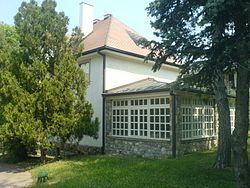Established 1 May 1950 | Dissolved 2003 | |
 | ||
Similar City Museum Vrsac, Muzej Ras, Narodni muzej Šabac, Народни музеј, Postal Museum | ||
The Museum of 4th July in Belgrade, Serbia was a museum located in the house where members of the Central Committee of the Communist Party of Yugoslavia decided to encourage the people's uprising against Yugoslavia's German occupiers on 4 July 1941. That date was later dubbed Fighter's Day, a public holiday in the Socialist Federal Republic of Yugoslavia.
Contents
Located at number 10/A Boulevard Prince Alexander Karađorđević, the museum opened on 1 May 1950.
The building is marked by a memorial plaque. A monument entitled Call of the Uprising, sculpted by Vojin Bakić, adorns the front of the building.
Notable residents
History
The house was built in 1934 by Vladislav Ribnikar. Before the outbreak of World War II, a shelter was buried in the back yard, and the building itself was prepared as a base for illegal operations. In the first years of the war, it hid illegals. and for some time was used by the Yugoslav Partisans (NOVJ).
In 1943, after Vladislav and his wife Jara departed with the Partisans, the house was confiscated and occupied by German officers.
After Yugoslavia was liberated at the end of World War II, the Germans left the house empty and vandalized. Ribnikar gave the house to the Communist Party of Yugoslavia to form a museum.
The Republic of Serbia declared the building a Monument of Culture of Exceptional Importance in 1979, granting it protected status.
In 2003, the museum was closed, and the property was returned to the Ribnikar family. Also, in the same year, Ribnikar Fond decided to use old Museum building, and open new museum, called "Museum of Politika and Serbian press".
